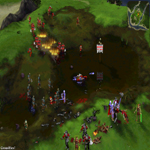
All were bombarded by bolides that saturated their surfaces with impact craters and pools of impact-melted mafic protocrust that fractionated into layered igneous complexes. Multidisciplinary evidence indicates that Earth, Mars, Venus and the Moon thoroughly fractionated early-by 4.5–4.4 b.y.-to form cores, refractory mantles and thick mafic crusts. The Cambrian explosion of evolution produced almost all phyla of modern animals within about 50 m.y., possibly because the newly-formed strong dipolar magnetic field provided a shield against ionized radiation. Organic evolution may have been enabled by these geodynamic changes. Lithosphere motions are well documented by palaeomagnetism which suggests Earth's internal strong dipolar magnetic field may have developed at ~600 m.y. The Phanerozoic is the era of plate tectonics. Only near the end of the Proterozoic did downward recycling of fusible components enable a weak asthenosphere to develop over which lithospheric plates could slide. Proterozoic paleomagnetic data cast doubt on the existence of a strong dipolar magnetic field at that time and there is no compelling evidence for Phanerozoic-like plate tectonics. Proterozoic dynamics were driven by vertical variations in density, reflect primarily the deposition and collapse of basins, and involved small horizontal motions only. This hydrous melting was enabled by a bombardment of icy bolides. Where these basins thickened to ~40 km their deep regions partly melted by their own radioactivity and they were “inverted” by materials rich in highly evolved hydrous granites rising to mid-crustal level. During the Proterozoic basins of volcanic and terrigenous sedimentary rocks formed on and between Archean shields. Archean crust is granite and greenstone with no modern analogue. The remaining stabilized TTG crust was then directly underlain by primordial low-density dunitic shallow mantle. This delaminated and sank to at least 200 km beginning top-down re-enrichment of the mantle. tonalite-trondhjemite-granodiorite (TTG) crust formed by hydrous partial melting of a mafic protocrust leaving dense, depleted, garnet-rich residue.

Earth's Archean was the era of internally mobile crust.

These include the claim that the Lu-Hf and Sm-Nd isotope systems can uniquely define oceanic rocks, acceptance of the “CHondritic Uniform Reservoir” (CHUR) model and a steadily depleting but fertile mantle, and belief that Proterozoic rocks exhibit features resembling those of Phanerozoic plate tectonics. Several defective assumptions have hindered understanding the evolution of Earth and its nearest neighbors.


 0 kommentar(er)
0 kommentar(er)
